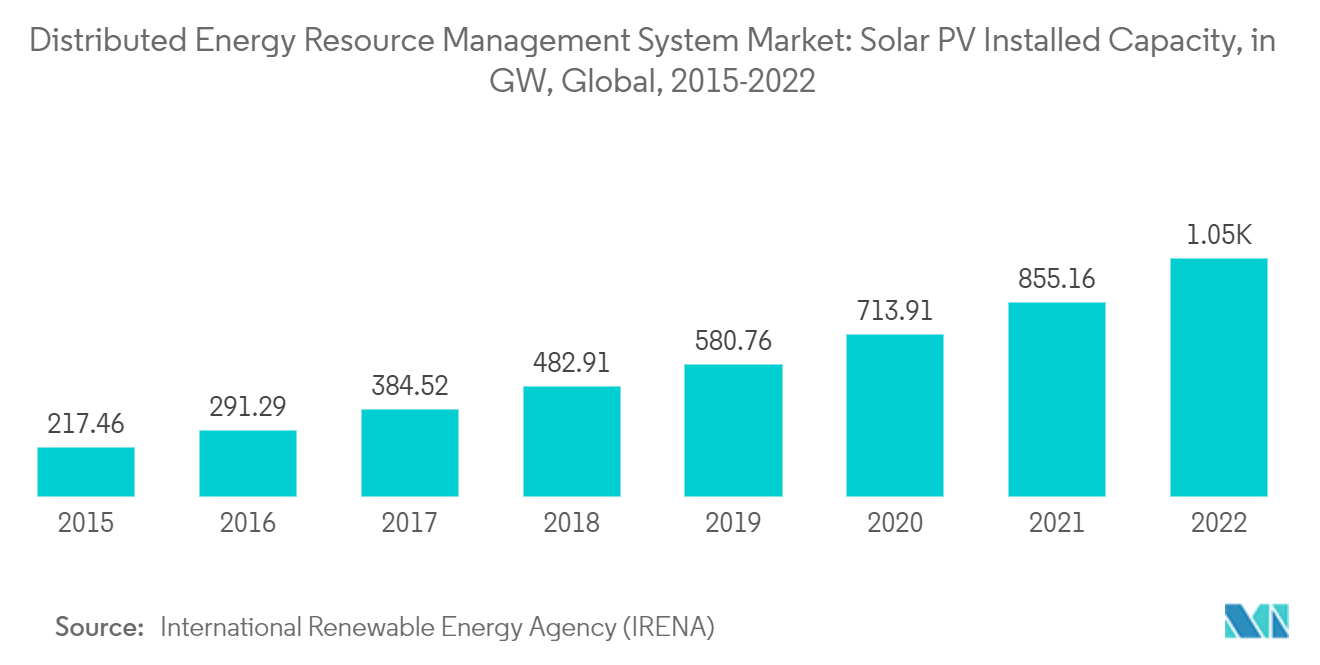Market Trends of Distributed Energy Resource Management System Industry
Solar Photovoltaic (PV) Segment to Dominate the Market
- Solar PV can be located on rooftops or ground-mounted and is one of the largest distributed power sources globally. This segment is expected to drive the distributed energy resources management system with increased installed capacity supported by decreasing average installed cost (USD/kilowatt). Distributed energy resource management systems limit real-time photovoltaic (PV) output to prevent reverse flows and high local voltages.
- Distributed generation is economically viable, requiring significantly less capital than an equivalent traditional facility. Tax incentives for both solar stations and distributed solar generation are driving distributed solar PV globally.
- According to the International Renewable Energy Agency, the global solar PV installed capacity accounted for 1,046.61 GW in 2022. With an annual growth rate of 22.4% compared to the previous year and supportive solar PV targets of the government, solar PV capacity is expected to increase in the future, which, in turn, may drive the distributed energy resource management system market.
- Cost reductions are expected to strongly boost PV expansion in China, the majority being utility-scale projects. Distributed solar PV capacity is also expected to increase rapidly, driven by new auctions for commercial and industrial applications and subsidies for residential systems.
- India's solar PV installations in 2022 reached 62.8 GW, up from 49.34 GW in 2021. The total includes utility-scale, rooftop, and distributed-generation solar capacity. Hence, with the increased adoption of solar as distributed power, the demand for distributed energy resource management systems is expected to grow.
- India has an ambitious plan of generating about 280 GW of sun-fired electricity by 2030 and outlined plans to spend an additional INR 19,500 crore to boost local manufacturing of solar modules. In the United States, solar PV investments rose significantly, supported by corporate procurement.
- Therefore, with increased investment in solar PV and changing government regulations, coupled with upcoming projects, the solar PV segment is expected to be the largest market during the forecast period.

North America to Dominate the Market
- North America led the DERMS market in 2022. It is further expected to be the largest market during the forecast period, supported by the United States and Canada, which have more than a million distributed generation units.
- Despite enough power generation and accessibility of transmission and distribution networks, power outages are caused in some areas of the region due to natural disasters, such as flooding and storms. The use of remote power systems, such as DERMS, to regulate distributed energy systems is likely to mitigate the issue.
- Distributed solar PV generation is expected to witness significant growth due to relatively low initial costs and a reduction in service costs, leading to a short return on investment. Many states, such as California and Texas, have introduced several laws for integrating renewables, such as installing rooftop solar PV, which is expected to boost the growth of the market.
- As of 2022, more than 300 remote Canadian communities relied on power-generating infrastructure that limits energy security, environmental health, and economic growth. Compared to a traditional central power generator, the faster process of approving and developing a distributed generation system facilitates a quick-off-the-ground electrical system to supplement and extend the use of aging infrastructure, especially in remote areas.
- Many North American utilities need better ways to manage and control assets in their distribution system. The high penetration of distributed energy resources (DER) is set to play a vital role in achieving emission targets and meeting higher energy demand.
- As per the International Renewable Energy Agency, the United States installed 111.53 gigawatts (GW) of solar PV capacity in 2022, greater than 93.91 GW in 2021. This is expected to create demand for distributed energy resource management systems.
- Therefore, based on these factors, North America is likely to be the largest market for distributed energy resource management systems during the forecast period.

